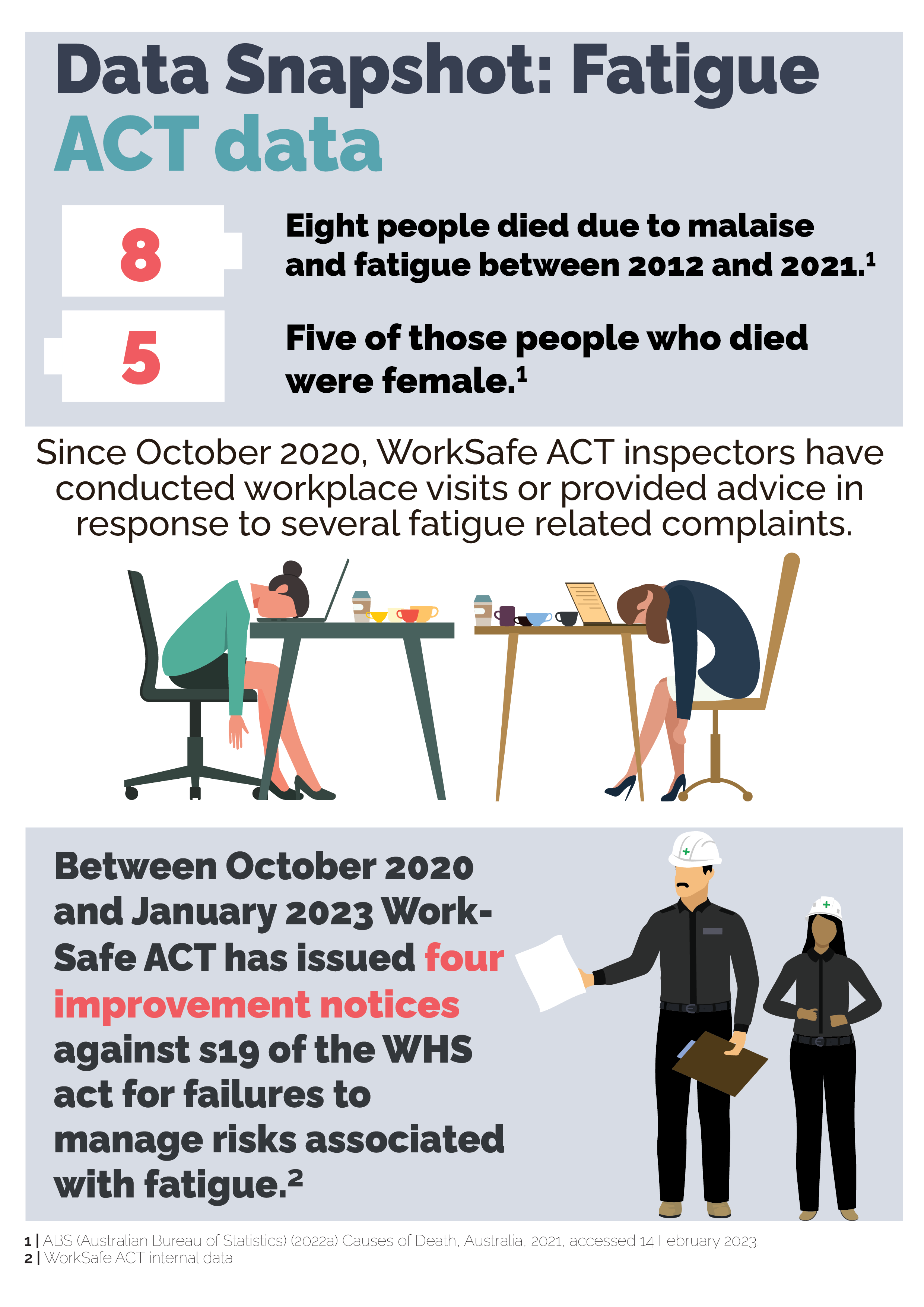
Data snapshot - Fatigue
Background
Fatigue is more than feeling tired and drowsy. In a work context fatigue is mental and/or physical exhaustion that reduces a person’s ability to perform work safely and effectively.
Causes of fatigue include:
- prolonged or intense (e.g., mental or physical) tasks or jobs
- sleep loss or disruption to your internal body clock
- organisational change
- travel
- uncomfortable or hazardous working environments (e.g., working in heat)
- work scheduling
- excessively long shifts
- not enough time to recover between shifts
- long commuting times.
Fatigue can adversely affect safety at the workplace. Fatigue reduces alertness which may lead to errors and an increase in incidents and injuries, particularly when:
- operating equipment and machinery
- undertaking critical tasks that require a high level of concentration
- undertaking night or shift work when a person would ordinarily be sleeping (SWA n.d.).
The following signs or symptoms may indicate a worker is fatigued:
- excessive yawning or falling asleep at work
- short term memory problems and an inability to concentrate
- noticeably reduced capacity to engage in effective interpersonal communication
- impaired decision-making and judgment
- reduced hand-eye coordination or slow reflexes
- other changes in behaviour, for example repeatedly arriving late for work
- increased rates of unplanned absence.
A fatigued worker may also experience symptoms that are less obvious to others, including:
- feeling drowsy
- headaches
- dizziness
- difficulty concentrating
- blurred vision or impaired visual perception
- a need for extended sleep during days off work (SWA n.d.).
Persons conducting a business or undertaking (PCBU) have a duty to ensure, as far as reasonably practicable, that workers are not exposed to health and safety risks at work. This involves adopting strategies to manage the risk of fatigue. Workers also have a duty to take reasonable care for their own health and safety and that their acts or omissions don’t adversely affect the health or safety of others (SWA n.d.).
Download the PDF version of this snapshot here:
National data
The Work-Related Injuries Survey, a nationally representative survey conducted by the Australian Bureau of Statistics in 2013-14, found that shiftworkers are at a higher risk of work-related injury than other workers. The injury rate for shiftworkers (49.9 injured workers per million hours worked) was more than two times higher than the injury rate for non-shiftworkers (23.2 injured workers per million hours worked) (SWA n.d.).

In terms of work-related injuries, fatigue due to insufficient sleep, disrupted sleep patterns or extended working hours was the most cited risk factor.
As per the research, the industries with higher shift worker injury rates are manufacturing; accommodation and food services; and public administration and safety.

Interestingly, shiftworkers who are machinery operators and drivers have a significantly lower injury rate than their non-shiftworker counterparts making this occupation unique because there is no other occupation in which shiftworkers have significantly lower injury rates than non-shiftworkers (SWA n.d.).
Between 2012 and 2021, the cause of death for 907 Australians was malaise and fatigue. 68% of these deaths were among females (ABS 2022).

ACT data
Since October 2020, WorkSafe ACT inspectors issued several notices to PCBUs for failing to manage work load risks.

PCBUs have received notices to ensure so far as reasonably practicable, the health and safety of workers by reviewing current safe systems for managing and monitoring workers’ workload and fatigue and for failing to develop a system to regularly review the controls/measures to ensure they remain fit for purpose, are being implemented, set up and followed correctly.

While fatigue has been a factor in several workplace concerns or complaints reported to WorkSafe ACT, there have not been any notifiable incidents reported to WorkSafe ACT.
Between 2012 and 2021, 8 people in the ACT died due to malaise and fatigue and 62% of these were females (ABS 2022a).

WorkSafe ACT's response
Between October 2020 and January 2023 WorkSafe ACT’s general inspectorate team and construction inspectorate team has conducted several workplace visits in response to fatigue-related complaints.
During this period, WorkSafe ACT has issued four improvement notices against s19 of the WHS act for failures to manage risks associated with fatigue.
WorkSafe has published a safety advice note on work-related fatigue on its website.
Resources for PCBUs and workers
Safe Work Australia, Fatigue management - a worker's guide
Safe Work Australia, Work-related fatigue and job design
Safe Work Australia, Guide for Managing the Risk of Fatigue at Work
WorkSafe ACT, Work-related fatigue
References
ABS (Australian Bureau of Statistics) (2022), Causes of Death (Australia), accessed 14 February 2023.
ABS (Australian Bureau of Statistics) (2022a), Cause of Death (Australian Capital Territory), accessed 14 February 2023.
SWA (2016), A Comparison of Work-Related Injuries Among Shiftworkers and Non-Shiftworkers, accessed 10 February 2023.
SWA (Safe Work Australia) (n.d.) Fatigue Management - a worker's guide, accessed 13 February 2023.
WorkSafe ACT, Fatigue, accessed 14 February 2023.
On this page


